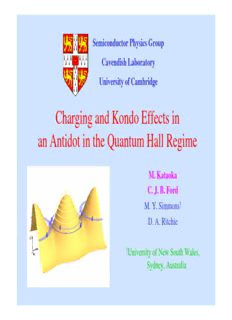
Charging and Kondo Effects in an Antidot in the Quantum Hall Regime PDF
Preview Charging and Kondo Effects in an Antidot in the Quantum Hall Regime
Semiconductor Physics Group Cavendish Laboratory University of Cambridge Charging and Kondo Effects in an Antidot in the Quantum Hall Regime M. Kataoka C. J. B. Ford M. Y. Simmons† D. A. Ritchie †University of New South Wales, Sydney, Australia Outline • Introduction Quantum Hall effect Antidots • Aharonov-Bohm oscillations Spin-splitting Double-frequency AB • Charging of an antidot Detector How does an antidot charge up? • Double-frequency AB Compressible & incompressible regions • Kondo effect Many-body effects at intermediate B • Injection of just one spin Non-equilibrium injection into edge state • Conclusion The Quantum Hall Effect • Quantised Hall resistance R and zeroes in longitudinal resistance R H L The Quantum Hall Effect • Magnetic field B is perpendicular to two-dimensional electron gas (2DEG) (cid:1) Landau levels • Transport is via edge states at the chemical potential (µ L and µ on left and right edges respectively) R AA HHaallll BBaarr with an Antidot • Opposite edges too far apart for backscattering (cid:1) (cid:1) no dissipation R = 0 (Quantum Hall Effect) L • Antidot (a bump in potential) brings edges close together (cid:1) • Overlap tunnelling, backscattering • Confinement is produced by the magnetic field B Antidots Gate •Three separate gates tune tunnelling across two constrictions • Aharonov-Bohm Effect fi States enclose multiples of h/e in flux • Tunnelling fi resonant backscattering (dips) or transmission (peaks) Aharonov-Bohm Effect • Fully spin- split at high B • Spin splitting at intermediate B • No AB oscillations below 0.2 T since no edge states yet h/2e oscillations only from outer spins (cid:1) • Squeeze constrictions symmetrically h/2e oscillations die • Then n = 1 plateau gives way to h/e oscillations c • Proof that h/2e resonances are only through outer spin state • But how can resonances occur twice per h/e period? Detection of Antidot Charging • Transresistance dips match transconductance oscillations • Net charge Dq around antidot shows saw-tooth oscillations M. Kataoka et al., Phys. Rev. Lett. 83, 160 (1999) (Samples made by G. Faini, D. Mailly, LPN - CNRS, Bagneux, France) How does an antidot charge up? • Very like CB in a dot, but sweep B not gate voltage • Squeezing comes from change in area of quantum-mechanical states
Description: